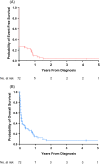Outcomes of pediatric acute myeloid leukemia treatment in Western Kenya
- PMID: 34811958
- PMCID: PMC9575503
- DOI: 10.1002/cnr2.1576
Outcomes of pediatric acute myeloid leukemia treatment in Western Kenya
Abstract
Background: Pediatric acute myeloid leukemia (AML) is a challenging disease to treat in low- and middle-income countries (LMICs). Literature suggests that survival in LMICs is poorer compared with survival in high-income countries (HICs).
Aims: This study evaluates the outcomes of Kenyan children with AML and the impact of sociodemographic and clinical characteristics on outcome.
Methods and results: A retrospective medical records study was performed at Moi Teaching and Referral Hospital (MTRH) in Eldoret, Kenya, between January 2010 and December 2018. Sociodemographic and clinical characteristics, and treatment outcomes were evaluated. Chemotherapy included two "3 + 7" induction courses with doxorubicin and cytarabine and two "3 + 5" consolidation courses with etoposide and cytarabine. Supportive care included antimicrobial prophylaxis with cotrimoxazole and fluconazole, and blood products, if available. Seventy-three children with AML were included. The median duration of symptoms before admission at MTRH was 1 month. The median time from admission at MTRH to diagnosis was 6 days and to the start of AML treatment 16 days. Out of the 55 children who were started on chemotherapy, 18 (33%) achieved complete remission, of whom 10 (56%) relapsed. The abandonment rate was 22% and the early death rate was 46%. The 2-year probabilities of event-free survival and overall survival were 4% and 7%, respectively. None of the sociodemographic and clinical characteristics were significantly associated with outcome.
Conclusion: Survival of Kenyan children with AML is dismal and considerably lower compared with survival in HICs. Strategies to improve survival should be put in place including better supportive care, optimization of the treatment protocol, and reduction of the abandonment rate and time lag to diagnosis with sooner start of treatment.
Keywords: Kenya; low- and middle-income countries; pediatric acute myeloid leukemia; sub-Saharan Africa; survival.
© 2021 The Authors. Cancer Reports published by Wiley Periodicals LLC.
Conflict of interest statement
The authors declare that there is no conflict of interest.
Figures


References
-
- Ward E, DeSantis C, Robbins A, Kohler B, Jemal A. Childhood and adolescent cancer statistics, 2014. CA Cancer J Clin. 2014;64(2):83‐103. - PubMed
-
- Lam CG, Howard SC, Bouffet E, Pritchard‐Jones K. Science and health for all children with cancer. Science. 2019;363(6432):1182‐1186. - PubMed
-
- Creutzig U, van den Heuvel‐Eibrink MM, Gibson B, et al. Diagnosis and management of acute myeloid leukemia in children and adolescents: recommendations from an international expert panel. Blood. 2012;120(16):3187‐3205. - PubMed
-
- Klein K, de Haas V, Kaspers GJL. Clinical challenges in de novo pediatric acute myeloid leukemia. Expert Rev Anticancer Ther. 2018;18(3):277‐293. - PubMed
MeSH terms
Substances
LinkOut - more resources
Full Text Sources
Medical

